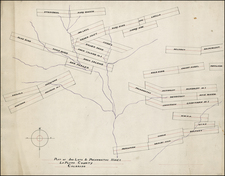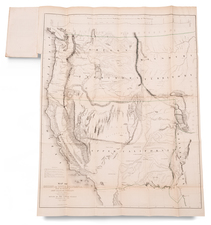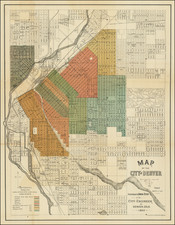The Only Printed View of Elizabethtown (soon to merge with Georgetown) with A View of Empire City at the Height of Its Importance
Nice example of this rare early pair of views of Empire City and Elizabethtown, in Clear Creek County, Colorado, from Alfred Edward Mathews Pencil Sketches of Colorado, published in 1866.
The view shows these two mining towns in Clear Creek County, which at the time one one of the richest mining counties in America. Elizabethtown existed for only a few years, before being merged into Georgetown. Empire, by contrast, boomed for nearly a decade, before it was supplanted by Georgetown by the end of the 1860s and the most important mining town in Clear Creek County.
A.E. Mathews (1831-1874) came to the United States at an early age and was raised in Ohio. He worked as a typesetter, itinerant bookseller, and school teacher, with a predilection for landscape sketching. During the Civil War, Mathews served in the Union Army with Ohio troops for three years, making topographical maps and views. and produced images of scenes behind the front which were issued by Ehrgott & Forbriger.
In 1865, Mathews moved to Denver, where he produced a number of portfolios of views of the Rocky Mountains, Colorado and Montana, including his important 1866 Pencil Sketches of Colorado.
Colorado Territory was formed following the discovery of gold in the mountains above Denver in 1858, which was followed by the 1859 Colorado Gold Rush. By the time Mathews arrived in Denver, it was one of the most important mining regions in America and the hub of commerce for the Rocky Mountains and Western Plains.
Mathews' work captured this transient and foundational moment in the history of Colorado. The work is very rare, with only a few complete sets changing hands in the prior decade and single plates from the work are often among the earliest accurate depictions of the regions sketched by Mathews.
Empire City
Empire City was originally founded in 1860 after gold discoveries in the area, with the town first named Valley City. In 1861, its name was changed to Empire City, and eventually simplified to Empire.
With the commencement of road construction in 1861, the town's accessibility and prospects began to improve. The discovery of valuable ore in 1862 near Empire marked a significant turn in the town’s fortunes, transforming it into a prosperous mining center.
Empire served as the heart of the Union mining district, transitioning from a gold to a major silver-producing area. By September 1862, Empire City, sometimes referred to as the "Rocky Mountain Metropolis," had developed to include around 70 buildings, with numerous individuals employed in the mines. The discovery of the Tenth Legion mine in late 1862 further bolstered the town's mining industry, attracting additional workers and investment. This growth in Empire led to a temporary decline in the nearby town of Georgetown during the winter of 1862-63.
However, the prosperity of Empire was short-lived. By the late 1860s, Georgetown had surpassed Empire as the regional hub. By 1870, Empire’s population had decreased significantly, with only about 150 residents, one hotel, one store, and a couple of mills remaining.
Elizabethtown, Colorado
Elizabethtown was immediately adjacent to Georgetown, Colorado. The town was first settled with the discovery of silver in 1864, the first such silver mining in what had previously been a gold mining region.
Elizabethtown was platted in 1865. In 1867, a second survey and plat of the town was made by Charles Hoyt, an employee of the Bullion Silver Mining Company. Originally, the area consisted of a sparse cluster of cabins near Burrell Hill, known as Elizabethtown in honor of a sister of the Griffith brothers, influential figures in the area.
However, in a landmark meeting held at the corner of Rose and Mary streets, the citizens voted to rename their town Georgetown, with a decisive three-fourths majority favoring the change. This change was later formalized in the town charter, granted by the Territorial Legislature on January 10, 1868.













![(Colorado Photographs) [Collection of 22 Rocky Mountain Scenery cabinet cards, including views of Denver, Georgetown, railroads, mining relating scenes and more]](https://storage.googleapis.com/raremaps/img/small/93382.jpg)
![[ Denver Panorama ] Panoramic View of Over 200 Miles of the Rocky Mountain Range Distinctly Seen from Denver with the Naked Eye; also the Principal Business Portion of Denver](https://storage.googleapis.com/raremaps/img/small/88876.jpg)